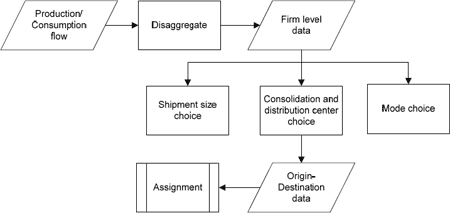MPC
Research Projects (2009-10)
Identifying Number
MPC-330
Project Title
Integrate Supply Chain Model in Urban Freight Planning
University
North Dakota State UniversityProject Investigators
Subhro Mitra, Denver Tolliver
Description of Project Abstract
Urban freight planning is more complex than urban passenger transport in many respects. The complexity of the planning process arises from the fact that movement of freight in an urban area is a part of logistics chain for diverse goods moved from points of production via warehouses and distribution centers to final destination, which might be another industry or end user. Some of these freight movements are comprised of full truck load (FTL) deliveries whereas some are less than truck load (LTL) pick up and deliveries at different locations.
Commodities categorized as urban freight are very broad and can be subdivided into diverse groups; and each group of these commodities has its own set of supply chain models. An approach to solve this problem would be to model the flow of these groups of commodities separately. A broad category of these commodities are building and construction materials, food and consumer goods, industrial inputs and waste products. The product grouping and supply chain pattern will also determine the truck type used for delivery of goods for these product groups. A categorization of the vehicle used in urban freight movement can be done based on the market sector they operate in; for example: courier, general carrier, specialist commodities, over-sized carriers and external carriers. This approach of disaggregating commodities into separate groups necessitates availability of data for these individual groups hence it might include time consuming surveys of shippers and carriers.
The modeling steps for urban freight are similar to those of passenger vehicle trips but certain considerations must be taken during the modeling process. Zones used for urban freight modeling may or may not be the same as those used for passenger vehicle trip models. There might be special generators like ports, rail terminals, intermodal terminals, truck depots and distribution centers. The network used in a freight model might be the same as a passenger vehicle trip model, but the movement of freight might be restricted on certain routes only.
Many of the existing freight models lack the supply chain management practiced by private sector to optimize the total cost, starting from inventory storage, to selection of distribution center, model and timing of delivery and the size of package to be delivered. The transportation of freight which is a part of the supply chain process cannot be studied in isolation. Based on the commodity group supply chain models can be built to optimize the total cost comprising of logistics costs and other service related costs. The logistics cost consists of transportation, warehouse, order entry, administration and inventory carrying costs. Service related costs include opportunity cost and loss of perishable goods, etc. The supply chain model introduces the distribution legs in the P/C matrix. Flow of goods from the producer to warehouse and distribution center minimizes the total logistics cost and introduces the distribution legs.
Project Objectives
Freight planning which had been relying on the methodology of passenger travel demand forecasting is not able to capture the intricacies of freight flow which are based on optimization of supply chain model for individual industries. In order to implement the supply chain model there is need to develop much higher resolution data base of production, attraction, distribution and storage location of individual commodities or commodity groups. The supply chain model not only determines the origin, destination and intermediaries but it also identifies the mode of transport and truck types most suitable for moving the freight; though, in urban freight, mode choice is not a big issue as the majority of the freight moves in trucks. The objective of this project is to advance state-of-the art methodology of urban freight planning by incorporating supply chain model in it. An aggregate-disaggregate-aggregate model will be used in this research. The steps used in the modeling process are:
- Disaggregating the Production-Consumption matrix to individual firms or group of firms producing certain commodities.
- Incorporate logistics decision of the individual firm or firm group to determine shipment size, consolidation and distribution center, mode of transport.
- Aggregate individual firms' information to develop an Origin-Destination matrix representing the actual freight flow.

MPC Critical Issues Addressed by the Research
Focus Areas Addressed by Research:#14 Traffic Operations and Management
Critical Issues Addressed by Research
- Development of advanced analytical framework.
- Better freight modeling capability
- Enhanced capability to predict mode choice and size of shipment.
- Innovative data collection methodology.
- Improved freight forecasting capability.
Contributions/Potential Applications of Research
- Improvement in urban transportation planning
- Justify infrastructure investment for highway expansion
- Identify intermodal locations to reduce truck traffic
- Study sensitivity of fuel price and highway cost on mode choice
Technology Transfer Activities
The project will produce several tangible benefits for researchers and transportation practitioners, including:
- Improvement in freight modeling technique
- Freight demand modeling to support to public-sector decision making
- Public-private partnership to exchange information and improve highway performance
Time Duration
July 1, 2009 through June 30, 2010
Total Project Cost
$199,540.00
MPC Funds Requested
$95,000.00
TRB Keywords
Supply Chain, Logistics, Distribution Center, Freight, Urban Planning
Literature review
- Jong, de G., Ben-Akiva, M and Florian, M. Specification of a logistics model for Norway and Sweden, European Transport Conference 2005
- Deste, G. Urban freight movement modeling, Handbook of transport modeling, Pergamon, 2005
- Clarke, M. Initial Development of an Innovative Commodity Flow and Truck Model for the Greater Los Angeles Basin, International Chinese Transportation Professionals Association Annual Conference, 2005

